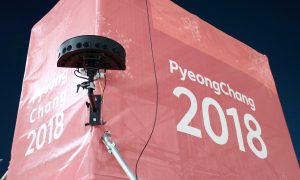Live From PyeongChang: Intel Partnership Brings Stability to VR Efforts
30 events get live, on-demand virtual-reality coverage
Although, in the early days of these PyeongChang Games, much was made of the elegant drones used in the Opening Ceremony, U.S. tech giant (and IOC sponsor) Intel is also playing a key role in creating the global virtual-reality experience of the Winter Olympics.
Working in collaboration with Olympic Broadcasting Services (OBS), NBC Sports, and Eurosport, Intel is delivering live and on-demand VR content for 30 events to viewers using Oculus Rift and Samsung Gear VR headsets.

An Intel True VR rig acquires footage of the Women’s Skeleton Finals at one of the first turns of the Alpensia Sliding Centre.
For each event receiving the VR treatment, at least three 4K stereoscopic pods are strategically placed throughout the venue. The pods contain 12 cameras each, some shooting in 4K.
A noted difference from the VR offering for Rio 2016 is that Intel and OBS are offering a 180-degree stereoscopic view of live action. According to OBS Head of Digital Matt Millington, 180-degree works fine because, at many positions, the view behind the camera is of little interest, and it’s an overall better use of streaming bandwidth.
“The picture quality is better,” says Millington. “Some people do prefer the 360 just because it offers more of a feeling of being there: you can look all the way around you. But, with the live [shots], 180 stereoscopic gives a much crisper image with less latency.”
With the live experience, viewers are able to choose their own camera angles or select to view a “VRCast,” a version of the show cut by a VR director with inserted graphics and (sometimes) audio commentary.
At this year’s Games, there has been a stronger emphasis on providing on-demand content. For Rio 2016, maybe one piece of on-demand content was posted per day. Here, there’s a minimum of two or three pieces per day. The on-demand content is more experiential and is offered in 360 degrees. It places viewers in the heart of the action: for example, viewers can experience a downhill slalom run for the perspective of a skier’s helmet.
According to Millington, OBS has found the 360-degree, on-demand content to be some of the most popular among users. That’s from anecdotal evidence gained in watching guests interact with the experience at a demo station in the lobby of the IBC.

OBS’s Matt Millington (back), with four students providing VR demos to guests at the IBC. The students are from an outreach program implemented by the OBS to offer temporary tech jobs at the Games to local youth.
“We’re getting in our analytics,” he says, “but I haven’t had my analytics of the exact clips people are watching. Certainly, empirically, from just watching people, they all go straight to the downhill skiing or the ski jump [in on-demand].”
Much as OBS does for its live-streaming Olympic Video Player (OVP), the broadcast service offers raw SDKs (software-development kits) with which rightsholders can integrate VR streams into their own new or existing consumer-facing apps. It also offers a white-label version of a VR app, providing simpler (but less customized) implementation. All those tools are built by Intel and facilitated through OBS.
OBS has, admittedly, lacked some continuity in its VR production over recent years (i360 was its VR partner for Rio 2016), but now, with Intel on board with a sizeable corporate sponsorship, there should be some stability for future Olympics.
OBS knows that, for many consumers, especially in the West, VR is still a work in progress, but it wants to remain on the cutting edge of the growth process for this evolving medium.
“The truth is, the only people who use [VR] for long periods of time are the gamers,” says Millington. “Sports is still quite niche in VR, and it hasn’t really taken off yet. We know there are huge amounts of investment going into VR. It’s evolving, and we believe it has legs and is going to get better.”
